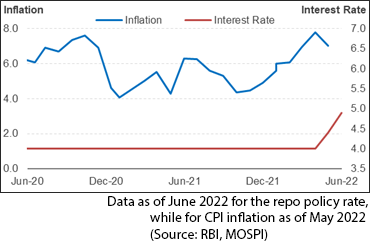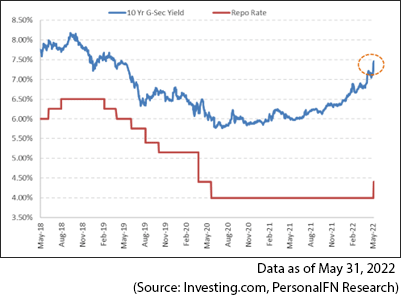India's Third Giant Leap
This Could be One of the Biggest Opportunities for Investors
- Home
- Views On News
- Jun 16, 2022 - Best Debt Funds to Invest in 2022
Best Debt Funds to Invest in 2022

The risk-off trade has made a strong comeback of late. Investors are reducing their equity exposure and seeking suitable options across fixed-income avenues.
Why?
Policy rates have been increased by most central banks to control spiralling inflation.
In India, CPI inflation has breached the RBI's upper tolerance limit, mainly because of higher food and fuel inflation.
Graph 1: CPI inflation versus Repo Policy Rate

Even in the U.S. with retail inflation hitting a 40-year high of 8.6% in May 2022, the Federal Reserve (US Fed) has taken a hawkish approach.
In May 2022, the Fed hiked rates by 50 bps, and just yesterday in the June 2022 meeting, the Federal Open Market Committee hiked the rate by 75 bps (the highest since 1994) - but much in line with expectations. It was also decided to raise the target range for the federal funds rate to 1.50% to 1.75% per cent and anticipated that ongoing increases in the target range will be appropriate.
As a result, the U.S. dollar index has risen to a level of 105 and global equity markets have been witnessing a sharp meltdown.
The Reserve Bank of India (RBI) as well raised policy rates twice in the last two months - cumulatively by 90 bps. And in the last monetary policy, it has decided to remain focused on the withdrawal of the accommodative stance.
Table 1: RBI Monetary Policy Actions
| Month | Repo Policy Rate | Policy Action (Basis points) |
Policy Stance |
|---|---|---|---|
| Feb-19 | 6.25% | -25 | Neutral |
| Apr-19 | 6.00% | -25 | Neutral |
| Jun-19 | 5.75% | -25 | Accommodative |
| Aug-19 | 5.40% | -35 | Accommodative |
| Oct-19 | 5.15% | -25 | Accommodative |
| Dec-19 | 5.15% | Status quo | Accommodative |
| Feb-20 | 5.15% | Status quo | Accommodative |
| Mar-2020 (an exceptional off-cycle meeting) | 4.40% | -75 | Accommodative |
| May-2020 (an exceptional 2nd off-cycle meeting) | 4.00% | -40 | Accommodative |
| Aug-20 | 4.00% | Status quo | Accommodative |
| Oct-20 | 4.00% | Status quo | Accommodative |
| Dec-20 | 4.00% | Status quo | Accommodative |
| Feb-20 | 4.00% | Status quo | Accommodative |
| Apr-21 | 4.00% | Status quo | Accommodative |
| Jun-21 | 4.00% | Status quo | Accommodative |
| Aug-21 | 4.00% | Status quo | Accommodative |
| Oct-21 | 4.00% | Status quo | Accommodative |
| Dec-21 | 4.00% | Status quo | Accommodative |
| Feb-22 | 4.00% | Status quo | Accommodative |
| Apr-22 | 4.00% | Status quo | Accommodative |
| May-2022 (Off-cycle meeting) | 4.40% | 40 | Accommodative |
| Jun-22 | 4.90% | 40 | Turned focus on withdrawal accommodative stance |
(Source: RBI Monetary Policy Statements)
This means the policy rate would continue to move up in the near future as inflation rears its ugly head. Global financial markets are anticipating even bigger rate hikes in the future.
--- Here's something interesting (Advt.) ---
The Biggest Money-Making Opportunity In The Recent Years
It is here!
We promised, and we are delivering.
We are proud to announce the launch of one of our most passionate projects ever.
Just Launched Active Wealth Multiplier 2030
It is something that could make you potentially wealthier by as soon as 2030 if you play your cards right.
And this is your opportunity to become a member of this high potential opportunity under this special launch offer.
As a member, we have a very special surprise for you that you could know all about HERE.
We suggest you read all about this huge opportunity right now.Because the founder member offer will not be here forever.And we don't want you to be left behind.
Go ahead, and become a member of 'Active Wealth Multiplier 2030' right now.
Now is the time to act.
Click Here To Become A Member Under The Special Launch Offer!
------------------------------
It's a good idea to revisit your asset allocation during such testing times and optimise your exposure to debt funds.
Deterioration in the inflation outlook is reflected in bond yields. India's 10-year benchmark bond yield has crossed 7.50%. The odds of it rising further cannot be ruled out as policy rates are hiked.
Chart 1: The 10-year benchmark yield has hardened

Moreover, factors such as increased government borrowings, higher debt-to-GDP ratio, weak rupee, and overall economic uncertainty, could push the benchmark bond yield further. So far this year it has climbed over 110 bps, the fastest pace since the year 2008.
With yields hardening, the interest rates on fixed income instruments also have moved up. That's why were are seeing re-allocation from equity to debt as an asset class.
It makes sense to focus on wealth preservation while wealth creation remains your ultimate objective. This is an opportunity to earn decent returns by investing in bonds.
However, you ought to approach debt as an asset class carefully. Don't assume investing in debt funds to be safe or risk-free. The fact is that it's not; there is interest rate risk, credit risk, and re-investment risk involved.
In the current times, where interest rates are likely to move it makes sense to take exposure to the shorter end of the maturity cover than the very long end.
Keep in mind, that longer duration instruments with a maturity profile in the range of 5 to 10 years are likely to more vulnerable to interest rate risk than the shorter maturity ones.
Under such a scenario, avoid selecting the 'best performing debt funds' based on their past performance. The sub-category and scheme that performed well in the past not necessarily will do well in the future. Such an approach could prove to be extremely risky.
Pay attention to your risk profile and your time horizon when investing in debt funds.
If you have a low-risk appetite (conservative investors) and your time horizon is less than a year, Liquid Funds might be the best-suited category for you.
But if you are a moderate risk taker and have an investment horizon of 2 to 3 years, you may consider Banking & PSU Debt Funds with a maturity of upto 3 years.
And with the same time horizon, if you do not mind taking slightly more risk, consider corporate bond funds that have held consistent exposure to top-rated debt papers.
Also, as far as possible, invest in funds following an accrual strategy, i.e. holding the underlying debt instruments until their maturities rather than engaging in yield hunting and taking a high risk.
To make your job simpler, at PersonalFN we have identified some of the best-performing schemes in the aforementioned sub-categories of debt mutual funds.
Table 2: 5 best funds to invest in 2022
| Scheme Name | Category | Returns (Absolute %) | Returns (CAGR %) |
||||
|---|---|---|---|---|---|---|---|
| 15 Day | 1 | 3 | 6 | 1 Year | 3 Years | ||
| Month | Months | Months | |||||
| Parag Parikh Liquid Fund | Liquid | 0.19 | 0.37 | 0.91 | 1.75 | 3.42 | 3.87 |
| LIC MF Liquid Fund | Liquid | 0.19 | 0.39 | 0.97 | 1.85 | 3.59 | 4.27 |
| IDFC Banking & PSU Debt Fund | Banking and PSU Fund | 0.13 | 0.3 | 0.21 | 0.93 | 2.77 | 7.33 |
| LIC MF Banking & PSU Debt Fund | Banking and PSU Fund | 0.1 | 0.27 | 0.24 | 0.87 | 2.52 | 6.19 |
| Aditya Birla SL Corp Bond Fund | Corporate Bond | -0.05 | 0.28 | -0.06 | 0.46 | 2.64 | 7.19 |
| Crisil Liquid Fund Index | 0.2 | 0.4 | 1 | 1.9 | 3.8 | 4.5 | |
| Crisil 10 Yr Gilt Index | -1.2 | -0.8 | -3.1 | -4.6 | -4.4 | 4 | |
Direct Plan and Growth Option considered.
Past performance is not indicative of future returns.
(Source: ACE MF, PersonalFN Research)
These schemes have a proven track record of performance, respectable portfolio characteristics, and are from fund houses following robust systems and investment processes. At PersonalFN, haven't seen them compromising on credit quality for greater returns.
For instance, as per the portfolio disclosed in May 2022, Parag Parikh Liquid Fund held 91.9% of its portfolio in sovereign debt, 1.4% in A1+, 0.7% in deposits and 6% in cash.
Similarly, IDFC Banking & PSU Debt Fund allocated 86.7% of its assets to the highest quality non-sovereign securities, i.e. securities issued by the quasi-government organisations as of 31 May 2022.
It currently has an exposure of 9.7% to sovereign securities and held 3.6% cash to tide over liquidity requirements.
Even Aditya Birla SL Corp Bond Fund, a fund that predominantly invests in debt securities issued by private sector players, has been following a conservative approach.
As per the May 2022 portfolio, it had only 5% exposure to securities rated below 'AAA' and no exposure to securities rated below 'AA'.
Always remember, when you invest in debt funds, your first aim should be the protection of your capital. Thus you should choose schemes with respectable portfolio characteristics rather than the ones engaging in yield hunting to clock extraordinary high returns.
Thus, pay close attention to portfolio traits of debt schemes before investing in them.
At PersonalFN we have always maintained that debt funds aren't risk-free but when selected carefully, they offer effective diversification opportunities.
Happy Investing!
Disclaimer: This article has been authored by PersonalFN exclusively for Equitymaster.com. PersonalFN is a Mumbai-based Financial Planning and Mutual Fund research firm known for offering unbiased and honest opinions on investing.


Equitymaster requests your view! Post a comment on "Best Debt Funds to Invest in 2022". Click here!
Comments are moderated by Equitymaster, in accordance with the Terms of Use, and may not appear
on this article until they have been reviewed and deemed appropriate for posting.
In the meantime, you may want to share this article with your friends!